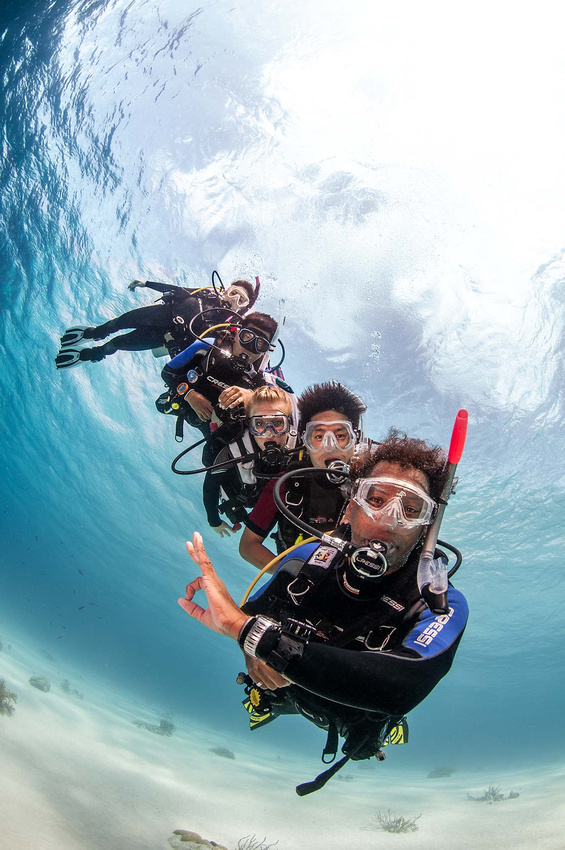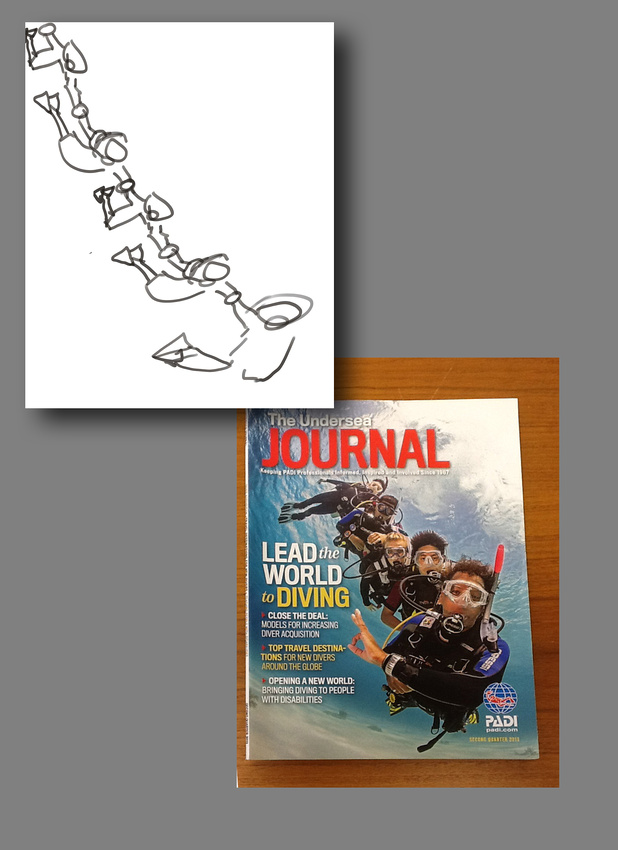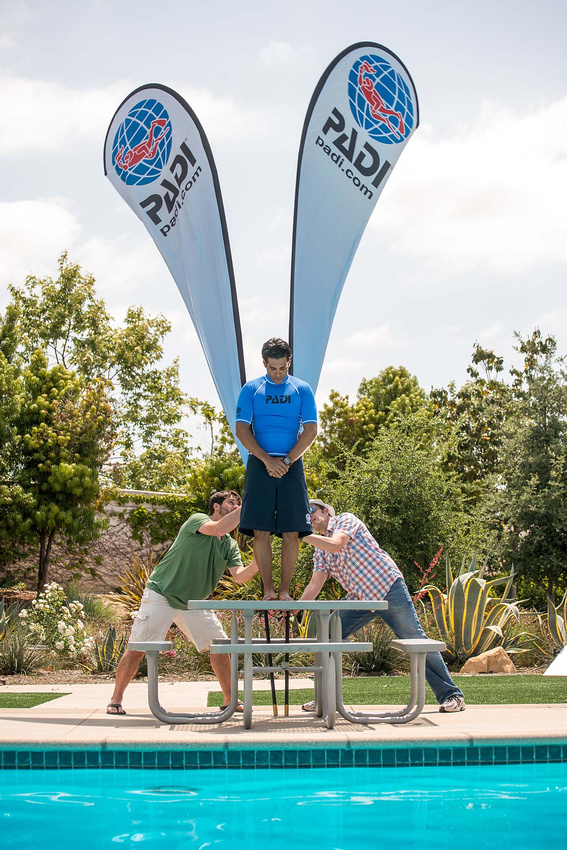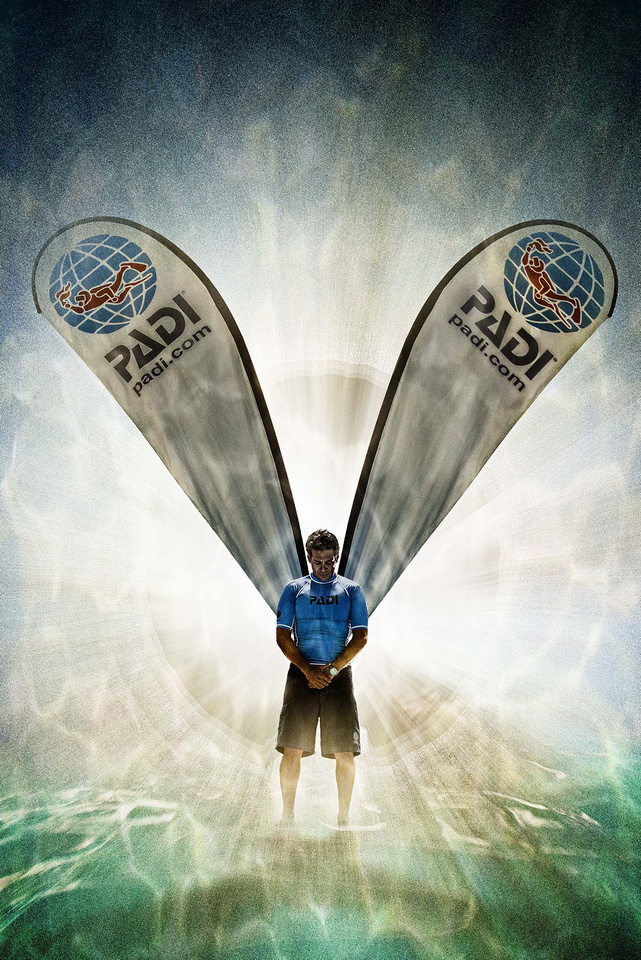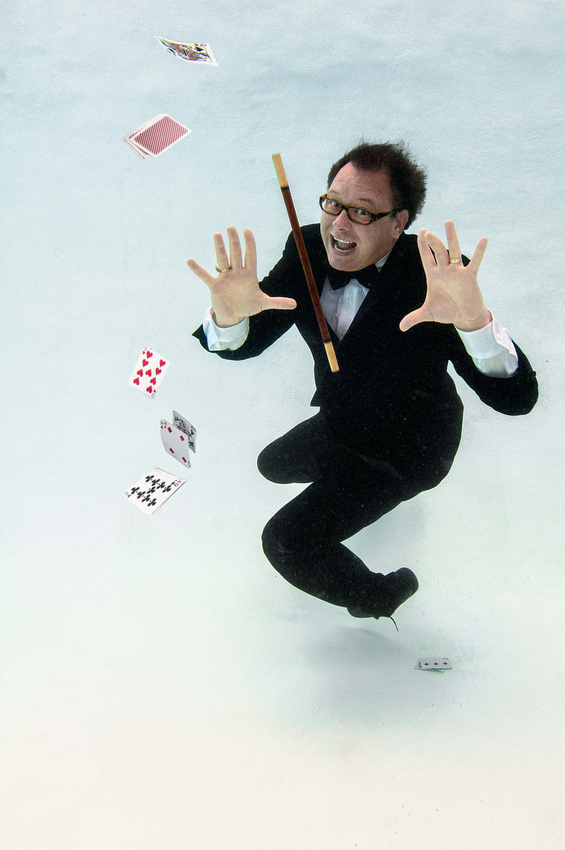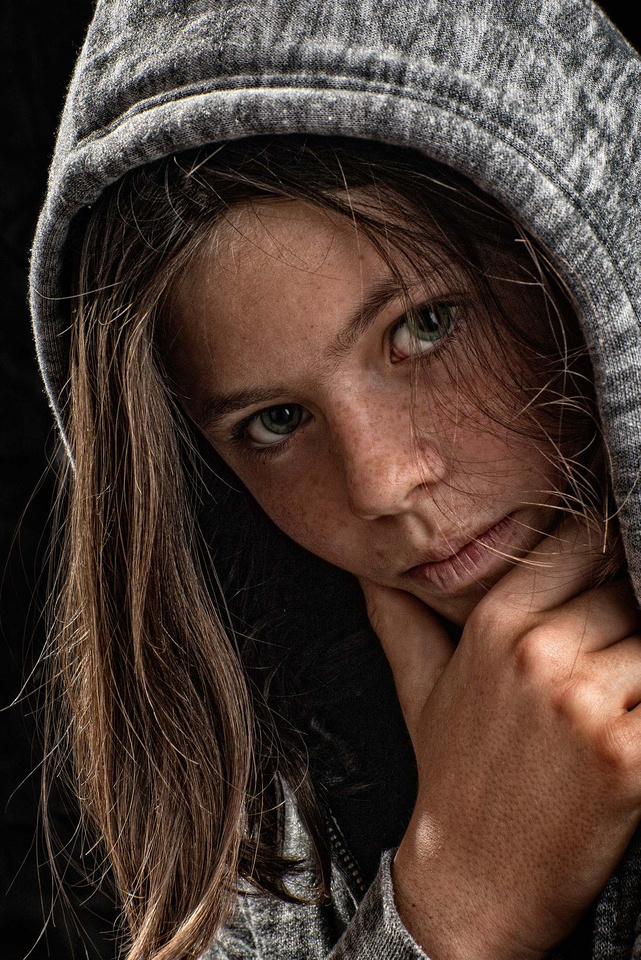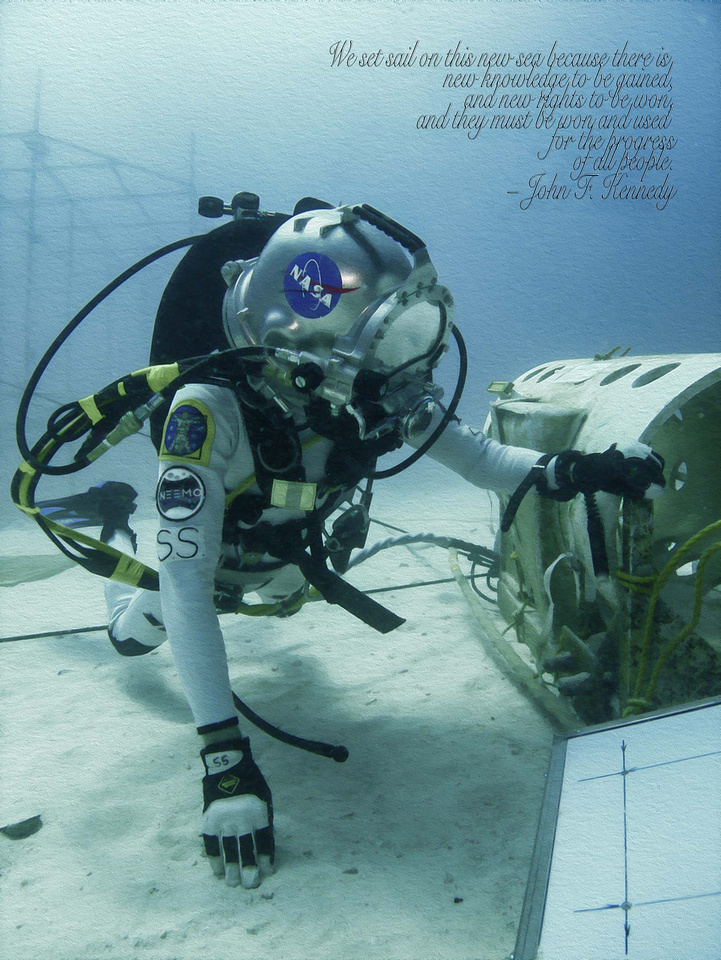|
Welcome to my online column. It's a few notes on what happens on different photo shoots and thoughts about shooting and image processing that may be useful to you if you're looking for my services as a photographic artist, or if you're a fellow shooter/image maker who works in the same areas in which I do. Perspiration and Inspiration
Sometimes people ask me where I get the ideas for some of the images I get to create (with the help of many, many talented people who work with me). My answer is sometimes we have to sweat out a concept, and sometimes a wonderful idea springs from the warped recesses of my mind, or the less warped recesses of someone else's mind.
The image above is an example of the first. Some of the professionals I work with on The Undersea Journal -- Theresa, Aja, and Todd -- and I were kicking around ways to show how PADI professionals lead people into scuba diving. We thrashed around one bad idea after another for at least an hour, until someone suggested that we be literal -- show someone leading divers, single file. I sketched out the concept (below -- and now you know why I shoot instead of draw) and suggested we shoot it almost vertical (which we did). The result was the image above, and the cover below.
The PADI "Angel" shot was the result of an idea popping to mind. We working on another project and it occurred to me that some of the banners we were using look like angel wings. During a break from the "real" work, my friends Mike, Abe and Hernan willingly delayed hard-earned breathers to execute the idea. This BTS (Behind The Scenes) shot shows the basic setup:
Here's the point: Whether "the" idea results from hours of beating our heads against the wall, or simply a flash of insight, bringing the concept to the computer screen (or to print or wherever it's going) takes work. These images weren't snapshots that got banged off in a moment. They took patience, teamwork, lighting and multiple exposures to get the needed capture, followed by hours (cover shot) retouching, and then even more hours (angel shot) crafting the final conception.
If you create a remarkable image, you may or may not have inspiration. But excepting a few lucky shots now and again, you will always have perspiration.
Think You Have What It Takes?
One of the most frequent requests I get is to shoot underwater models and portraits who are not scuba divers -- like this one of professional magician Scott Tokar. To get this shot, we were 12 feet deep and he's fully dressed, holding his breath. Besides me, there are two underwater photo assistants supporting (check out this behind scenes image). These types of underwater portraits and fashion are harder than they look for the subject/model. There's a lot more to it than sinking to the bottom of a pool for a moment while I snap-snap-snap. Forty years ago, underwater photos impressed people just because they were underwater. Today, even snapshooters take cameras underwater, so it's not enough if you want a striking image. Someone who can't pose effectively doesn't give me anything to work with, and that's the start point in imaging. Scott, who is both a professional photographer and experienced PADI Rescue Diver, shows what it takes:
1. Comfort in water. You have be to be completely and relaxed with your ability to hold your breath, swim and work in water. Being a scuba diver is helpful, but not necessary (I have photographed many talented models who were not divers). Scott can easily hold his breath and pose for 30 seconds, which doesn't include the time to get to the pose and to return to the surface or a scuba air supply to breathe. Notice that his mouth is open? He's not freaked out by letting water in it.
2. Eyes open. Scott's eyes are not only open, but they are wide open and they look just like they do if he weren't underwater. Many people squint or don't open them at all -- just doesn't work for imaging.
3. Playing to camera. Scott's cheeks aren't puffed out and he's playing to camera. He's expressive, giving us something interesting to see. He's using appropriate props and wardrobe. These are especially critical for this type imaging because the bottom of a pool is sterile and boring -- it's all him or we don't have anything worth looking at.
4. Using the environment. Scott's feet are off the bottom, with his wand and cards suspended in the water. There's no point in going underwater and then creating an image that doesn't differ from what you could take on dry land. Scott uses the water to give me a portrait that would take a lot of planning and Photoshop work out of the water.
Think you have what it takes? If so, let's give it a go.
Commit!
Portraits of people who are not professional models or actors work the same way. When you commit to the emotions and expressions I ask for, we're far more likely to end up with something special. This image of my goddaughter Corey is a case in point. The first couple of shots had no direction and as a result, were simply well-lit but ordinary images of a young lady. My bad for not giving direction, but fixable. Knowing that she's been doing some acting (see this image), I asked her to play a character who is being thoughtful. Without hesitation, she pulled up her hood and became contemplative. It was working, but not quite there, until I turned her to deepen the shadows. Ding!
Maybe you want (or need for specific purposes) something light, with a smile. No worries -- it's the same process. Commit to exhilaration, joy, contentment, rapture, hope . . . . whatever, just let the appropriate emotion take you over -- and that's what the camera will capture.
Applying the Pirate's Code to Imaging
In looking at this portrait, surely some purists will scream that this isn't Rembrandt lighting. That's because "true" Rembrandt lighting uses only a single light, whereas in this image, a second light source illuminates from image left. So? A good artist applies the Pirate's Code principle when following the classic lighting styles. As said by Disney's Barbosa: "And thirdly, the code is more what you would call guidelines than actual rules."
In creating this image, we started with classic Rembrandt, then adjusted until we had shots that work. Post processing adjusted color and midrange contrast to emphasize detail, so that we created a dramatic portrait rather than a vanilla headshot. Whether or not you agree we succeeded, we probably ended up with something different from what Rembrandt would have painted. Though I would never compare my work to Rembrandt's, I think Rembrandt would appreciate that today's artists build upon the principles that he and his contemporaries pioneered. He'd roll over in his grave if we used them as chains.
Fountain of Youth
For whatever reason, I often find I capture images of children that, based on the comments I get, speak to many people (a good skill to have as a dad, BTW). I'll share a secret -- imaging children well doesn't take patience. Well, it shouldn't, at least. When I put kids in situations where I need patience, I rarely get shots I like. This has taught me to avoid photoing children in the studio, and to avoid staging or posing them as much as possible. For me, the better approach is to put children where I have good light, let them be themselves and be ready to capture the special moments.
That's what I did with this shot of my daughter. Shooting someone facing away doesn't usually work, but in this case, her body language shows us her wonder at water cascading down a rock face into the pool. She is fascinated by water, so this waterfall fountain gave me more than a few moments to get a frame that reveals her fascination.
What child images speak to us? I think they're the ones that let us see the world through a child's eyes. They take us back, and remind us that there was to a time when waterfalls were new and wonderful, pinwheels were special and magical, and Saturdays seemed to last forever. They make us young again by reviving the children within us.
Legend has it that explorer Ponce de Leon spent more than a decade looking for the Fountain of Youth. He could have found what he was looking for in ten minutes with a youth by a fountain.
Praise for Photo Assistants
This is Niccole. Who is she? Let me tell you: Take away my light meter, my go-to softbox, the best lens in my kit or my number one tripod, but don't take away Niccole. Or Dawn, Shawn, Scott, Ted, Toby or many other talented people who assist or have assisted me when I shoot. All the attention is on the model/subject(s) and the photographer at a shoot because they're the place where all the work comes together, but they certainly don't do all the work. Assistants make a HUGE difference by making everything go more smoothly for everyone, because they do the little things that make a big difference. It's not always obvious just how big a difference they make.
For example, when I ask Niccole to turn a light slightly, it takes her less than a second to make the adjustment. I could do it, but I would have to walk all the way over and back, and that takes a minute. Twenty times on a setup means 20 more minutes to get the shot, so she saves your value time if you're the client. And, through experience, she knows precisely how much a smidge is when I say, "cheat the light a smidge toward talent. . . woof!" (For reference, a "smidge" is less than a "bit" but more than a "hair.")
When Dawn sets up a shoot, she does it faster and better than I ever could, and doesn't forget the details I invariably would. She also knows how to politely tell me to where to go when I tell her I want to reschedule so that I more than happly shoot at the time she sets to begin with. My friend Scott recently "assisted" me on a wedding for two close friends (I don't normally shoot weddings, but this was an exception). In his case, "assisting" meant "shoot the stuff I'm not good at shooting" because he's a way better wedding photographer than I am.
Good assistants like Niccole, Dawn, Shawn (that's my wife), Scott and so on make me look good. When you see Niccole whisper in my ear, she's not telling me my fly's open (not usually, anyway). She's reminding me (as I asked her to) to get the profile view you asked for. Or, more importantly, she's suggesting the shot that will be the one you absolutely love and give me the credit for. But, you won't hear her or Dawn or any of the others shout out their ideas. Why? Because that causes chaos. Good assistants flow everything through the shooter (or director in motion imaging) so good ideas don't die in the confusion of who listens to whom, when and why. (By the way, if you shoot but don't listen to your assistants' ideas, get over yourself and start listening. Otherwise, you'll not only stop getting their ideas, but you'll be adjusting all your lights yourself). Good assistants have great people skills, too. When I see Dawn whispering in a client's or model's ear, I know she's saying something reassuring, like "Please sign this model release, and don't worry, he's not as stupid as it looks."
Assisting is sometimes a sit-here-while-I-test-the-lighting job (so you don't have to if it's a shot of you). Usually, I delete test shots, but sometimes I get one I love. So, you now you get see the real talent.
Making a Zombie Diver
The "put-him-underwater" part would be the challenge. We didn't have time or funding to go on location, nor does most makeup hold up to being submerged, unless it's specifically for underwater (and even then it doesn't last long).
We solved the problem by shooting this image in the studio. The model, Tod, is not underwater at all. Here's how I crafted the shot:
First, I went through my library of stock images (it's always great to have a library of stock images) and found shots of a ship model I'd taken about four years ago. The model was about 3.5 feet long, so I had taken multiple shots to give it a relatively even focus. I composited the shots together, then, created the color, lighting effects, silt, haze and so on to create the background.
In the studio, I shot straight down on Tod, who is looking straight up. The lighting was set up vertical-for-horizontal to match the background shot. I took the master of Tod and then retouched it to make him more zombie-ish (Tod doesn't really have the big dent in his head), then composited it on to my background. To blend it smoothly, in compositing I created transitions of color-haze-silt and so on so that our zombie looks realistically like part of the shot, yet separates to create the sense of depth (that is, 3D depth, not diving depth). The finishing touch was borrowing some bubbles from one of my underwater images.
The image was a big success. Perhaps the biggest compliment I get is from photographers -- including underwater shooters -- who don't realize this isn't a real underwater shot. There's another composited zombie shot you can check out (not underwater) of Tod and zombie Dawn (Dawn of the dead) in front of a spooky barn (again, created for the shot).
A caution: If you think this kind of image manipulation replaces the need to actually take underwater images on location, guess again. The time it takes to do it in Photoshop is so long that if you have more than two or three images you need, it's more time and cost effective to shoot underwater for real.
Losing NEEMO
Since 2001, I've been blessed and privileged to work on the NASA NEEMO (NASA Extreme Environment MIssion Operations) as a trainer, diver, investigator, support person and yes, photographer. These missions operate from the Aquarius habitat off of Key Largo, Florida. If you're not familiar with it, Aquarius has been the underwater equivalent of the International Space Station for more than 20 years. It sits in 60 feet of water in the John Pennekamp underwater preserve, and allows scientists to live underwater for periods ranging from a few days to a couple of weeks. It's not a submarine -- divers live in it at the same pressure as the surrounding ocean.
Operated by NURC (National Underwater Research Center) and owned by NOAA, Aquarius is a national treasure. In its career, it has hosted hundreds of unique undersea research projects -- unique in that there is no other underwater habitat like it in operation anywhere, by anyone. Beginning in 2001, NASA started running NEEMO missions to study spaceflight dynamics. A crew of four NASA divers --usually three astronauts and a scientist -- along with two NURC diver/operators -- explored different aspects of humans in space. What made Aquarius a one-of-a-kind test bed is that it is an analog environment, not a simulation. The missions were real missions, and NEEMO teams actually depended upon their life support systems to stay alive. The 16 NEEMO missions researched many questions that need answers as we move deeper into space, ranging from handling a medical emergency on Mars to the best way to explore an asteroid. The missions conducted interactive, web-based outreaches into schoolrooms and attracted high profile divers and explorers from around the world. Peripheral tasks broke new ground -- I was personally involved in creating a mosaic map of the Carpenter Basin in which Aquarius sits. The map took literally thousands of overlapping images and then joined them together to create a map with so much detail, you can zoom in on individual fish
Despite incredible knowledge gained (at a fraction of the cost to do so in space) through the NEEMO projects, as well as hundreds of marine research studies, Aquarius and its NEEMO missions are coming to an end. Unless some miracle occurs, Aquarius -- which can be operated for years for the cost of a single space shuttle flight -- will shut down at the end of 2012 due to government budget cuts. For all the things we see our tax dollars wasted on, it seems tragic that this useful, proven facility will be gone. As I write this, a team is slowly -- reluctantly -- dismantling the support operation facilities.
The image you see here is one I captured during what is likely the final Aquarius based NEEMO mission. It shows a NASA scientist working with mockups for asteroid-based exploration, and he's wearing a Kirby Morgan diving helmet, which is a good analog to a space suit; the white coveralls echo the white worn by astronauts. The Kennedy quote was from the speech that launched us to the moon; I used a very classic type font and gave the image painted look to honor the classic quote and suggest a moment worth special remembrance. When I created this last summer, none of us really thought we were conducting the last mission. Ironically, it was the most advanced, progressive and ambitious mission yet -- a lot done and a a lot learned. (Check out the clips on YouTube, including this one.
Actually, NEEMO will likely survive -- the project explores other extreme environments on Earth as a way of learning more about what we need to know to explore space. But, its inception and heart lie with the Aquarius underwater habitat.
If we as a country can't afford Aquarius, maybe a soft drink company like Red Bull can.
UPDATE: Aquarius and NEEMO survived! At the last minute Florida International University (FIU) took over Aquarius. Replacing NURC, FIU upgraded the operation and moved the shore base, so today it's doing well -- but continues to need public support. NEEMO continues to go there, with 20 missions as of August 2015. NEEMO XXI is scheduled for July 2016. Be sure to friend NEEMO in Facebook and follow @NASA_NEEMO. Panning For Gold
Every so often, it pays to go through your image files to look at your rejects with fresh eyes. It's a bit like panning for gold where it seems the vein has tapped out -- there's still treasure, but you have to sift through more junk to find it. These hiding gems don't jump off the screen like your big winners do, but they're worth your effort if you take the time to look. We captured this image last March while shooting stills for the PADI Tec 60 and Tec 100 CCR Diver courses. On first pass, it looked a bit under exposed (actually, contrasty for those of you who know photography), and there was a lot of silt (suspended particulate matter). But, those problems are easy to fix in processing. Having done so, my goal was show the viewer the delight and joy you see on the model's faces, so in addition to localized color correction and other steps I use with underwater imagery, I added the texture and selective sharpening that makes the final version "pop." (Yes, that's the technical term.) Lesson? If you're a photographer or photographic artist, go back through your didn't-make-its once in awhile to see what keepers got shuffled in. If you're a casual snapshooter, take some of those I'd-like-them-if-only images you never show (or shouldn't show) to someone who really knows Photoshop or Lightroom to see if they can be made into something.
|
